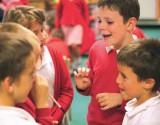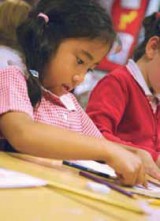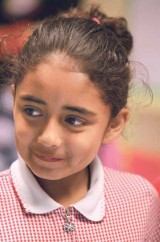Mathematics is not a solitary pursuit, says Peter Clarke.
All too often, due to the fragmented nature of the curriculum, the skills of speaking and listening that we develop with children in literacy lessons are not transferred to mathematics. This is especially the case given that maths is the one subject that is most often taught in isolation.
If we look at the Mathematics National Curriculum (2000) however, the skills of communication are firmly embedded. Attainment Target 1: Using and Applying Mathematics (AT 1) has three strands: Problem Solving, Reasoning, and Communicating. Of these three strands, we probably spend most time on problem solving. However, all three strands have equal weighting in the National Curriculum, so we should be spending just as much time in developing children’s reasoning and communication skills as we do their problem solving skills.
In fact, if we think about the process of reasoning, the more input the better. That’s obviously where the communication takes place. Without it, we always think - perhaps mistakenly - that we’re right!
It is for this reason that the majority of work related to AT 1 and problem solving is most effectively carried out in pairs or groups – to not only develop children’s problem solving skills but also their reasoning and communicative skills.
However, the world of mathematics comprises both pure and applied mathematics, and research suggests that collaborative learning improves both. It not only promotes communication, but also enhances children’s mathematical understanding when they explain their thinking and knowledge to each other.
 Results from the SPRinG (Social Pedagogical Research into Group Work) study - a one-year project by the Institute of Education at London University - suggest how group work is a powerful yet underused teaching strategy that can:
Results from the SPRinG (Social Pedagogical Research into Group Work) study - a one-year project by the Institute of Education at London University - suggest how group work is a powerful yet underused teaching strategy that can:
• raise attainment
• increase children’s engagement in learning
• improve classroom behaviour
Teachers, the study suggests, should act as ‘a guide on the side’ of groups, facilitating children’s learning, and steering groups when they encounter difficulties; as well as modelling and reinforcing good social and conversation skills, and key mathematical concepts, knowledge and understanding.
SPRinG also recommends a process of briefing and debriefing at the start and end of lessons which enables children to reflect on their learning and their group work skills (see below).
The teacher:
• introduces the topic
• checks prerequisites for learning
• introduces the activity
• checks for understanding
• clarifies any misconceptions
• ensures easy access to resources Paired or group work
The children:
• report back to the whole class
• reflect on their learning
• identify the ‘next step’. he teacher evaluates learning and paired or group work skills

Children sit in pairs, back-to-back. Provide one child in each pair - the speaker - with a physical object or a picture.
The speaker carefully describes the object or picture so that their partner - the listener - can recreate/draw it without looking.
The listener can ask questions to help them establish a mental image of the object or picture.
Tip
You could ask the speaker to make their own object or draw their own picture.
Ask each child to fold a sheet of A4 paper: at KS1, children fold the sheet three times; at KS2, children fold the sheet four times.
Children then write one digit in each of the small rectangles (see below).
Keystage 1
| 1 | 5 | 8 | 3 |
| 7 | 2 | 4 | 9 |
Keystage 2
| 1 | 5 | 6 | 4 |
| 3 | 0 | 2 | 9 |
| 5 | 8 | 3 | 8 |
| 2 | 1 | 7 | 0 |
Arrange the children into pairs. Children then take turns to say a statement that equires their partner to fold their sheet of paper, either horizontally or vertically, in such a way as to make different numbers that fulfil the statement. For example:
“Show me a multiple of 2”
5
..
2
6 : 4
1 : 7 : 0
“Make a number betwen 200 and 400”
2
..
3
..
7
2 : 1 : 7
3
..
5
..
2
Provide each group with a set of 20 cards consisting of the numbers and mathematical symbols used in four different calculations (make sure the numbers and symbols are all mixed up). Addition and subtraction, or multiplication and division cards are best.
Children work together to arrange the cards into the four different calculations.
Keystage 1
| 6 | + | 2 | = | 8 |
| 9 | + | 3 | = | 12 |
| 10 | - | 8 | = | 2 |
| 7 | - | 4 | = | 3 |
Keystage 2
| 9 | + | 6 | = | 15 |
| 15 | + | 6 | = | 21 |
| 21 | - | 12 | = | 9 |
| 17 | - | 13 | = | 4 |
Tip
Creating the cards on the computer and usingthe digits 6 and 9 adds an extra level of challenge to the activity.
This incredibly simple, yet deceptively challenging, activity provides opportunity for discussions on concepts such as the inverse relationship (6 + 2 = 8 / 8 – 6 = 2), and the commutative law (6 + 2 = 2 + 6).
Once groups have completed the activity, hold a whole class discussion where groups compare and discuss their results.
Group 1 answers
13 + 4 = 17
6 + 9 = 15
21 - 15 = 6
21 - 9 = 12
Group 2 answers
6 + 15 = 21
13 + 4 = 17
15 - 9 = 6
21 - 12 = 9
The different solutions provide further scope for discussion, such as the relationship between different trios of numbers, i.e. 4, 13, and 17: 4 + 13 = 17; 13 + 4 = 17; 17 – 4 = 13; 17 – 13 = 4.
 Children coose a card
Children coose a card
Keystage 1
Halving a multiple of 10 will give a multiple of 10.
When you add two numbers, you get the same answer aswhen you multiply them.
The difference between any two odd numbers is an even number.
Numbers with more digits are greater in value.
Keystage 2
A pentagon has fewer right angles than a quadrilateral.
If you add three consecutive numbers together, the answer is always even.
The sum of four even numbers is divisible by 4.
A pentagon has fewer right angles than a quadrilateral.
Groups work together to decide whether the statement is always, sometimes or never true and justify their reasoning.
• If groups consider a statement to be always true, they explain how they know this.
• If groups think a statement is sometimes true, they describe the cases when it is true and all the cases where it is false.
• If groups think a statement is never true, they explain how they know this.
 Rainbowing
Rainbowing
Each group member has a different colour or number. After initially working together as a group on an activity, new groups are created by placing children with the same colour or number together. After sufficient time, children then return to their original groups and share what they have learned.
Jigsawing
Different groups work on different aspects of a problem. Groups then share what they have learned with the rest of the class to complete the ‘jigsaw’.
Snowballing
Begin by working in pairs. Join two pairs to become a group of four. The groups of four then share ideas with other groups of four or become a group of eight.
Envoying
After initially working together as a group on an activity, one member from each group becomes their group’s ‘special envoy’ and moves to another group to share their group’s ideas and learn those of the other group. After sufficient time, the envoys return to their original groups and share what they have learned.
Speaker(s) and listeners
One or two children take the role of speaker and summarise, without interruption, the group’s findings. Afterwards, the listeners ask questions for clarification or to correct misconceptions.
Peter Clarke is a primary mathematics education consultant running courses throughout the UK and in Europe. He is a guest lecturer on PGCE, GTP and MA courses and a BEAM consultant. Peterhas written material for the National Numeracy Strategy, QCA, Collins, BEAM, Nelson Thornes and Pearson.
Teaching five year olds to talk
Ace-Classroom-Support
Use the bottle-flipping craze to create good school behaviour, not bad
Behaviour Management
Make every lesson an experiment
Cross Curricular
